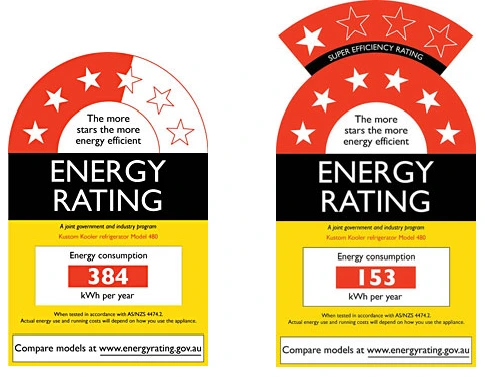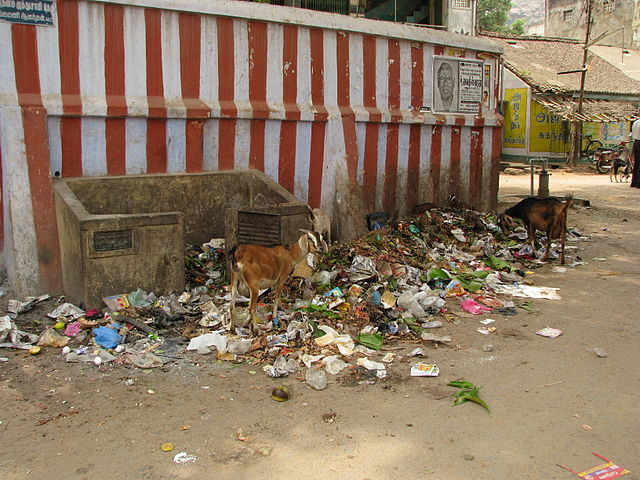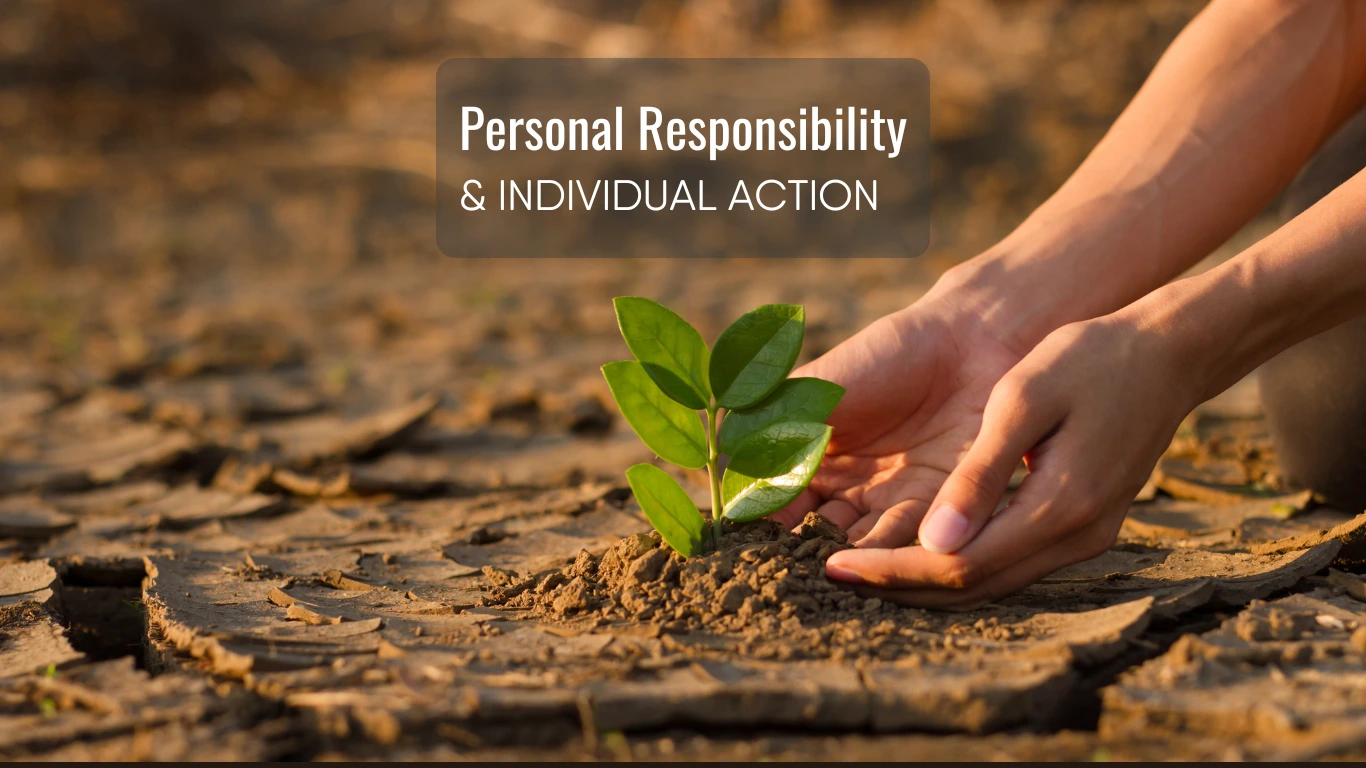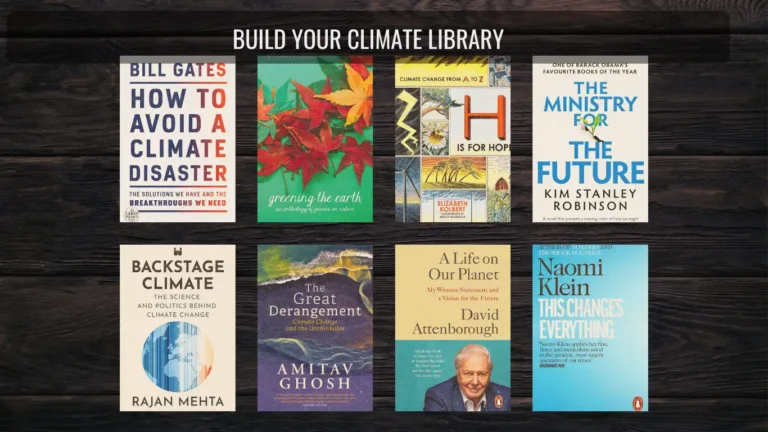INTRODUCTION
Climate Change is a global problem. It affects people from every nation, race, class, and caste. All organisms living on Earth are connected to Nature, and the degradation of the environment destroys entire ecosystems. In order to fight climate change and undo the harm induced by human activities, many organizations have come together to reduce greenhouse gas emissions and slow down global warming. As a result of this worldwide-global consensus, nations and international organizations like the United Nations have pledged to stop the average global temperature at 1.5° Celsius by the end of the century to mitigate climate change. Accordingly, all nations have come up with NDCs and other policies to mitigate climate change.
However, climate action is not just limited to large-scale global organizations. Individual and community action also has the power to create a serious impact on climate change, reducing overall greenhouse gas emissions and pollution. By a combined effort from individuals, consumers, technological advancements, and policies, humanity may succeed in mitigating climate change on a global level, paving the way for the birth of a new world – one that’s healthier, greener, and livable. This blog post explores various practices and ideas on how individual action (Personal Social Responsibility) can contribute to mitigating climate change.
Table of Contents
WHAT IS PERSONAL SOCIAL RESPONSIBILITY (PSR)?
The idea of personal social responsibility stems from a broader concept of social responsibility. Social responsibility is an ethical concept in which individuals, communities, organizations, and the state work towards the collective benefit of the community. Social responsibility means that the actions taken by all the members of a society create value, wealth, opportunities, and welfare for not just a few but everyone. Thus, it promotes inclusivity, equality, justice, freedom, and the cultivation of culture and environment.
Personal Social Responsibility implies that even a single person’s action can contribute towards the development of overall society. Basically, it means that each member of a society holds a social responsibility to also foster collective development along with personal growth in order to create a rich and meaningful society with value for all the members.
PSR’s ROLE IN CLIMATE MITIGATION
PSR plays a central and crucial role in fighting climate change and reducing energy consumption. This is because everyday individual actions like transportation, communication, production, and consumption compound into a snowball effect, resulting in large-scale greenhouse gas emissions and pollution. By cutting down GHG emissions at the root level, every individual holds immense power and potential to mitigate climate change. Essentially, it can save on costly, energy-intensive mitigation practices by adopting simpler and easier changes in lifestyle and consumption patterns to create a larger impact on society and the environment.
According to reports by the IPCC and EDGAR, the average GHG emission per person can range from 5-8 tonnes (refer to data above). This figure is impacted by various factors like national economy, energy use, an area’s culture and lifestyle, and everyday consumption practices. To achieve the goal of keeping the average world temperature increase to less than 1.5°C by 2050, individual emissions need to come down to 2.3 tonnes.
This major reduction is not possible through technological or policy-based interventions alone; it requires contributions at the individual and community levels as well. Simple yet significant changes at a personal level can trigger climate action across all sectors, helping to reduce GHG emissions in transportation, food, electricity, and other industries. Ultimately, personal social responsibility, coupled with innovative technologies and supportive policies, can complement each other to accelerate climate mitigation strategies and induce a massive paradigm shift, resulting in large-scale action against climate change. Thus, each individual’s action can create a ripple effect in cutting down GHG emissions and fostering a richer, eco-friendly lifestyle that benefits all.
HOW INDIVIDUAL ACTION CAN MITIGATE CLIMATE CHANGE
1. ECO-CONSCIOUS LIFESTYLE
The human population in urban landscapes is accustomed to a high-energy consumption lifestyle. People have access to private homes, cars, air conditioners, and numerous energy-intensive devices. While this has improved the general standard of living, it has also negatively impacted the environment, resulting in greenhouse gas (GHG) emissions, pollution, the extinction of natural species, and a loss of biodiversity. Since most human activities rely on energy primarily derived from fossil fuels, energy-intensive activities inevitably emit carbon into the atmosphere, contributing to global warming. Altering one’s lifestyle and making conscious decisions to opt for low-energy alternatives can significantly reduce emissions.

At its core, the problem of high energy consumption and overproduction is not just technical or economic, but also psychological, as it is directly related to human behaviour and understanding. A more aware and conscious consumer can help regulate the production, consumption, and waste cycle by opting only for items they genuinely need. This would result in prioritizing utility-based items over excess, filtering out high-quality products from worthless ones. According to a report by the National Geographic Society, emissions could be significantly reduced if consumers simply “buy less.”
One of the major problems with energy-intensive consumption practices is that they create the illusion of consumer demand. This, in turn, prompts increased production, which is a significant source of emissions and pollution. The aura of insatiable consumer demand fosters the illusion that production must increase to match this demand, but often, overproduction leads to market saturation, which ultimately culminates in waste. For instance, according to a USDA report, 31% of food products are wasted at the retail and consumer levels. They simply end up in waste bins, from where they must be collected, processed, recycled, composted, and so on. The amount of energy consumed and emissions released to manage this waste could be reduced if consumers were more aware of their demands and needs.
2. SMART TRANSPORTATION
Almost 7.10 billion tonnes of carbon emissions come from the transport sector. This is because the primary mode of commuting from point A to point B relies on energy derived from fossil fuels. Internal combustion engine (ICE) vehicles and the aviation industry are major sources of emissions and pollution worldwide, especially in high-income countries. Transportation is an inseparable aspect of human existence, and in many cases, it is absolutely necessary for survival. However, in various situations, smart and eco-conscious modes of travel can save money, reduce emissions, and promote a healthier lifestyle.
For instance, commuting to nearby locations, visiting the market, and covering short distances can be accomplished by walking, cycling, or using public transport. The switch from gas-powered ICE vehicles to eco-friendly, zero-emission vehicles can not only benefit the environment but also reduce noise pollution, traffic congestion, and everyday frustrations like road rage. Furthermore, simple physical activities like walking and cycling can encourage exploration of the city and local neighborhoods, creating a richer experience of urban living and increasing the livability index.
Opting for smarter and more intelligent travel alternatives can have a long-lasting impact on surface temperature, city design, pollution, and the overall experience of travelling in the city. A high density of cars means infrastructure is designed primarily for vehicles, resulting in large amounts of concrete on roads. Concrete and asphalt are responsible for trapping heat, contributing to the urban heat island effect, which raises temperatures and forces city dwellers to rely more on air conditioners. This creates a feedback loop that exacerbates environmental damage. All of these disasters can be averted by simply switching to eco-friendly and smarter modes of travel.
Shifting to natural and smarter mobility has the potential to develop advanced modes of human commuting. Personal choices, combined with corporate initiatives and policy support, can trigger a large-scale transformation in the transportation sector. The dip in emissions during the 2019-2020 COVID pandemic lockdowns demonstrated that individual and community actions can significantly impact sector-wide emissions, paving the way for a conscious shift towards sustainable methods. Ultimately, personal responsibility and global policy must work hand in hand to combat climate change, and individuals play a crucial role in reducing greenhouse gas (GHG) emissions.
3. HOUSEHOLD APPLIANCES AND AIR CONDITIONING
Everyday household activities, from cooking to cooling, often rely on gas-based technology. Appliances like stoves, boilers, and air conditioners, commonly found in most homes, contribute significantly to energy consumption and carbon emissions. While these devices have become a staple in modern households, there are practical alternatives that can significantly reduce their environmental impact.
One of the most effective ways to lower household emissions is by considering renewable energy sources like solar panels. Switching to electrical appliances and less energy-intensive instruments is another step towards sustainability. Energy-efficient appliances with high Star Ratings can be opted, as they use significantly less energy. These devices are not only cost-effective in the long run but are also more friendly to the environment, offering consumers a simple way to reduce their carbon footprint.

Excessive use of air conditioning can create a feedback loop where higher emissions lead to increased global warming and energy consumption. Promoting openness, ventilation, and natural ecosystems within living spaces can help maintain cooler environments without the need for air conditioners. According to the Heat Island Effect (HIF), areas dominated by concrete and asphalt tend to be hotter than natural zones, highlighting the importance of ventilated spaces, air channels, and shaded areas for a more comfortable and eco-friendly atmosphere.
Urban infrastructure, particularly in ‘smart’ cities like Gurugram, often features flashy glass buildings without basic elements such as windows or ventilation ducts. As a result, these buildings become dependent on air conditioning even during cooler months like October, traditionally an autumn season known for its pleasant winds. This over-reliance on air conditioning during times when it should not be necessary underscores the need for more sustainable building designs that incorporate natural ventilation and cooling mechanisms.
4. FOOD, DIET, & WASTAGE
Food and diet play a crucial role in the fight against climate change. The food sector is quite complex as on one hand it must meet the nutritional needs of the global population while on the other hand, it is a significant contributor to carbon emissions. Agriculture and livestock, in particular, are major sources of greenhouse gas emissions.
According to the Food and Agriculture Organization (FAO), livestock alone accounts for 14% of total global emissions. The entire food supply chain, from production to consumption, adds to this environmental burden, making it an area where individual action can have a meaningful impact.
One way individuals can help reduce emissions is by making changes to their diet and lifestyle. By shifting towards more plant-based and alternative nutritious diets, people can reduce their reliance on cattle and dairy products, which are heavy contributors to emissions. This doesn’t necessarily mean giving up meat entirely, but rather cultivating a more balanced diet that incorporates plant-based proteins and other sustainable food options. Small changes in what we eat can significantly reduce our carbon footprint.
In addition to diet, conscious buying habits and reducing food waste at the household level can make a significant difference. Food waste not only squanders valuable resources but also complicates waste management challenges.
For example, in Indian cuisine, dishes like curries and gravies, which are often rich in oils and spices, can be particularly challenging to manage once they enter the waste stream. These wet food items can decompose quickly, leading to foul odors, attracting pests, and increasing the risk of infections. Additionally, such foods can complicate composting and recycling efforts due to their high moisture content and potential for contamination.

On an individual level, food waste might seem trivial, but when accumulated, it creates a snowball effect that contributes to the formation of massive landfills, which are significant sources of methane—a potent greenhouse gas. Proper disposal of food waste and mindful consumption can alleviate some of these issues, reducing both environmental harm and the strain on waste management systems. By buying only what is needed and being mindful of portion sizes, households can significantly cut down on food waste, thus helping to mitigate its broader environmental impact.
CONCLUSION
Climate change is a global problem being addressed by large organizations, corporations, and governments. But that doesn’t mean that individuals are helpless.
Each person holds both social and environmental responsibility to cultivate a cleaner, healthier, and livable version of the planet that nurtures life and fosters the growth of its interconnected ecosystems. When individual efforts are combined with corporate initiatives, policy changes, and technological advancements, the cumulative impact can be substantial. Collective action, driven by small changes in daily habits, can sync with larger efforts to boost progress in addressing climate challenges.
By raising awareness, learning about sustainable practices, participating in community activities, and making eco-conscious lifestyle choices, individuals can make an immediate difference. Simple actions like reducing waste, conserving energy, and embracing eco-friendly alternatives can have a profound impact when multiplied across communities. Together, individual and collective efforts are key to tackling the pressing issue of climate change. After all, Climate Change is not just a global problem – it’s also personal.





